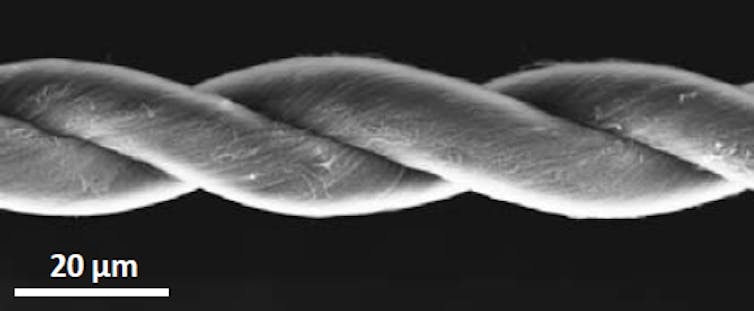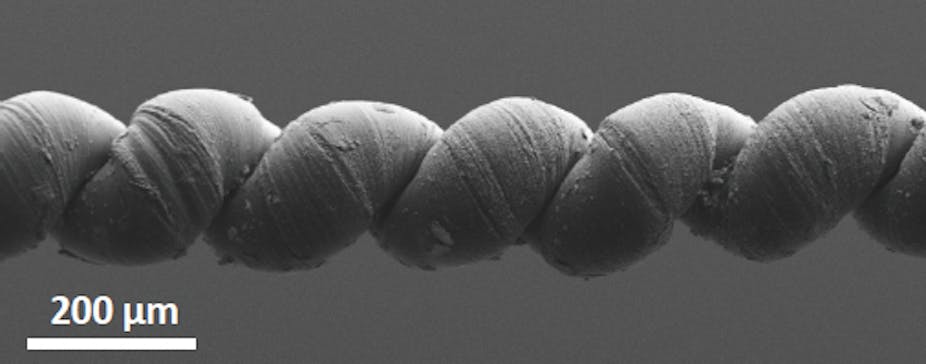Just on a year ago my colleagues and I announced our discovery that carbon nanotube yarns could be made to twist and rotate at great speeds when electrically stimulated.
In this way we had created “artificial muscles” that could change their shape in response to stimulus.
The rotating action of these yarns was used to turn a paddle in a microscopic mixer for fluids. Their small size prompted speculation that these “torsional actuating” threads could one day be used to propel flagella-like motors in futuristic micro- or nano-bots.
Over the past year the same team (with some new collaborators) has pushed the performance of these carbon nanotube artificial muscles to staggering new levels.
For a start we’ve been able to increase rotation speeds from 600 revolutions per minute (rpm) to more than 11,000 rpm. The maximum torque (turning force) generated is five-times higher than our previous record and now exceeds the torque generated, per mass, by large electric motors.

Equally exciting is the lengthwise contractions generated in the carbon nanotube yarns. Previously, we measured length contractions of about 1%, but now we can generate up to 9% contractions – similar to natural muscles.
These contractions are also very fast. For 3% contractions we can achieve 1,200 cycles a minute. The mechanical power per weight generated by these contractions is more than 85 times higher than that produced by skeletal muscle.
While these performance improvements are truly impressive, perhaps the most significant advance has been to take the artificial muscle out of the beaker.
Our previous carbon nanotube muscles were powered electrochemically and were configured just like a rechargeable battery with two electrodes (anode and cathode) immersed in an electrolyte (see video below).
The carbon nanotube yarns were used for one or both of the electrodes and when charged by applying a voltage, a small increase in yarn volume occurred that resulted in a partial untwisting and shortening of the yarn.
These shape-changes were harnessed for the torsional and contractile muscle actions.
Our new work has focused on other ways of changing yarn volume and the result has been the development of fully dry systems.
The most successful example to date has been to fill up the pore space within the yarns with paraffin wax (ordinary candle wax will do) and electrically heat the wax by passing a current through the yarn.
The wax expands and deforms the carbon nanotubes to generate the large and fast rotating or contractile actuations. These new dry actuators no longer need an electrolyte, a second electrode or the associated packaging used to stop electrolyte leakage.
An additional bonus is the wax-filled carbon nanotube yarns are much stronger and can be operated for much longer. We gave up testing after 2 million cycles of voltage pulsing where we saw no deterioration in performance.
Even simple exposure to light can be used to heat the paraffin within the carbon nanotube yarn and generate actuation.
Chemically stimulated actuation was also demonstrated by incorporating a guest material within the carbon nanotube yarns that is sensitive to specific chemicals.
When we added palladium metal to the carbon nanotube yarns we were able to generate reversible torsional actuation with hydrogen gas. Here the metal absorbs hydrogen and swells.
These actuators may be used to automatically close a safety inlet valve when hydrogen pressures exceed a pre-determined threshold.
Similarly, we can imagine “intelligent textiles” where body heat or sunlight cause actuation of yarns within the fabric. Imagine a garment that changes its porosity when the wearer gets hot or sweaty to release heat or moisture and then closes up again when the wearer cools down.
These applications are genuinely a step closer with the discovery of fully dry actuating yarns. While we have only measured actuation on single yarn threads at present, we are poised to weave, knit and braid these yarns into textile garments and explore their applications in smart textiles.
A curious feature we don’t fully understand is the amplification in actuation that occurs when we over-twist the yarn to form coils.
Over-twisting is easy to demonstrate on any thread or rubber band. Hold one end of the thread firmly and start twisting the other. At first the thread is uniformly twisted but above a threshold level of twist the thread will want to form a coil.
Twist-to-coil transitions can then occur by adjusting the tension on the thread: more tension will pull a coil out and generate more twist.
A non-coiled, twisted carbon nanotube yarn filled with paraffin can generate about 1% contraction in length when heated. Taking the same yarn and adding some extra turns so it becomes coiled will boost the contraction to 5% for the same heat input.
Coiling of threads (or “snarling”) is well known in the textiles industry and even has relevance to the structure and function of DNA.
Understanding the effects of coiling on the actuation of carbon nanotube yarns is part of our ongoing investigations into these fascinating systems.

